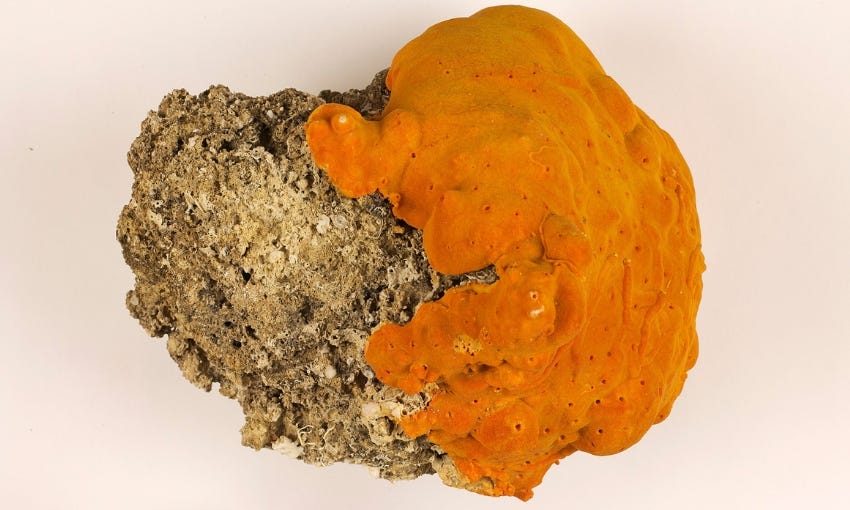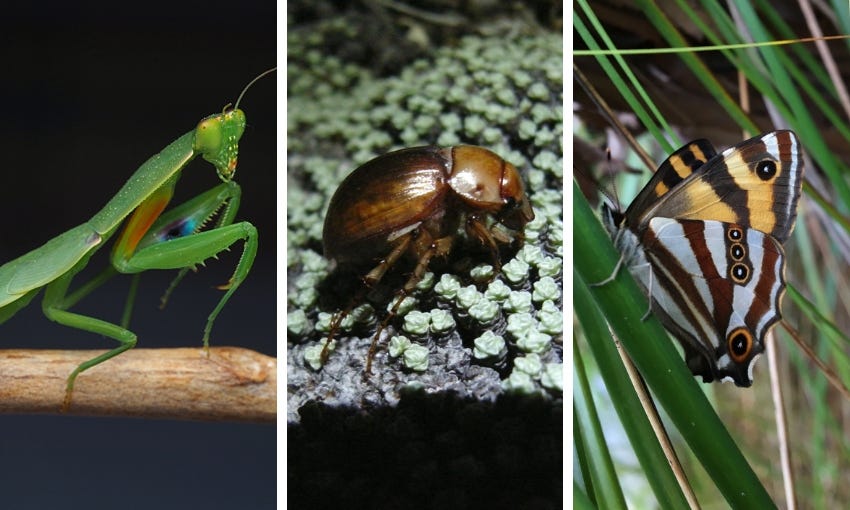Has the world already blown past 1.5°C?
A new study using sea sponges as ‘natural thermometers’ suggests yes, but other scientists challenge the claim.
Kia ora, welcome to Future Proof brought to you by AMP. I’m Ellen, thanks for joining me this week.
Ceratoporella sea sponge. Image credit: National Museum of Natural History/Smithsonian Institution.
Ancient sea sponges from the Caribbean Sea have sparked a climate science controversy this week, centred around the question: have we already passed 1.5°C of warming?
Here’s what the research entailed: six specimens of slow-growing sponges were collected from the ocean floor near Puerto Rico, between 30 and 90 metres deep. The sponges’ hard skeletons are a kind of “natural thermometer”, inscribed with a record of changing ocean temperatures dating back 300 years. These sponge thermometers showed that warming began around 1860, during the Industrial Revolution, and that, to date, we’ve accrued 1.7°C of warming.
That’s 0.5°C more than the IPCC’s estimate of 1.2°C, and exceeds the 1.5°C target enshrined in the Paris Agreement. “The big picture is that the global warming clock for emission reductions to minimise the risk of dangerous climate change has been brought forward by at least a decade,” said Malcolm McCulloch, lead author of the study. So, does this mean we’re cooked? Not so fast.
Scientists have criticised the framing of the study, pointing out that data from a single location shouldn’t be generalised to the whole planet. “A single new paleo record off the coast of Puerto Rico is a valuable addition to the large evidence of warming,” said Malte Meinshausen, professor in climate science at the University of Melbourne. “But it is just that, one study among hundreds. The IPCC's findings still stand strong.”
Then there’s the problem of shifting baselines. Usually, global heating is measured relative to the average temperature between 1850 and 1900, yielding the IPCC’s estimate of 1.2°C. This study hones in on a different historical baseline: the year 1860, when the temperatures began to tick upward according to the sponges. “The absolute degree of warming will always depend on the baseline and different groups have different definitions,” said Daniela Schmidt, Professor of Earth Sciences from the University of Bristol. “The absolute number should not be the focus of the discussion, though.” Carbon Brief has a thorough analysis of criticisms and limitations of the study.
Ultimately, whether our speedometer says 1.2 or 1.5 or 1.7, we’re still racing towards dangerous levels of heating. The overarching message is the same: slam the brake on emissions, because every fraction of a degree avoided makes a difference.
AMP believes that investing in a sustainable future is the best way to achieve long-term investment success. That's why they integrate environmental, social, and governance (ESG) factors into all of their investment decisions.
AMP supports companies that are making a positive impact on the world while avoiding those that are causing harm. AMP is also working to reduce its own carbon footprint and achieve a net zero outcome by 2050 or sooner.
A year on from Cyclone Gabrielle
“If there was one good thing to come from the cyclone, it was the way in which it brought people together – people who might never have met in their ordinary lives,” writes Rachel Morris in New Zealand Geographic, chronicling the fall-out and continuing clean-up efforts in silt-covered Hawke’s Bay.
covers the policy limbo, highlighting the perverse impacts of an ad hoc response to both the cyclone and floods (1,415 new homes consented on flood plains in Auckland!).Fast-tracking process for major infrastructure projects deemed a “war on our natural world”
A proposed law would see fast-track approval for major infrastructure projects via ministerial approval, with a consenting panel only having limited ability to decline projects. Gary Taylor of the Environmental Defence Society called the proposal a “war on our natural world.”
“All New Zealanders should be concerned because this could affect their backyard, their favourite recreational spot or beloved beach, river or mountain,” he said. Forest & Bird was similarly concerned, with chief executive Nicola Toki saying, “The lack of transparency and opportunity for the New Zealand public to participate in these processes is the most shocking thing.”
James Shaw’s climate legacy
Green Party co-leader and former climate change minister James Shaw announced he would be stepping down last week. Stuff’s Olivia Wannan outlines his climate wins, including the Zero Carbon Act and Emissions Trading Scheme reforms, and some losses, such as the axing of the “astonishingly successful” clean car discount. Shaw also spoke to Newsroom’s Marc Daalder about his legacy, and the “blazing rows” he had over pricing agricultural emissions.
The War for Wellington is being funded with support from The Spinoff Members.
If you think it’s important that Wellington becomes a modern, fit-for-purpose city that can live up to its potential, we would love you to become a member, or donate, and help us out. If your business is interested in supporting our Wellington coverage, we'd love to chat.
Sign up to receive our weekly War for Wellington newsletter, written by the Spinoff's Wellington editor, Joel MacManus
More stories
Pandora, the world’s biggest jeweller and maker of popular charm bracelets, no longer uses mined silver and gold, opting for recycled precious metals instead.
Possible sighting of a South Island kōkako in Southland raises hope that the species persists.
Here’s your guide to what you can and can’t recycle under the new nationwide rules – plus where to recycle those items no longer accepted in your kerbside bin.
A briefing from environment officials to the climate change minister says that New Zealand is not on track to meet its climate goals, with a scaling up of domestic action or purchase of international carbon credits needed to meet them.
Frustrated by the influx of pesky flies this summer? These underappreciated insects are just doing their best, Shanti Mathias argues.
The first penguin deaths from a highly lethal strain of bird flu have been reported from Antarctica.
Do socially disruptive climate protests actually work? It’s complicated.
Taylor Swift’s private jet carbon emissions come under scrutiny: “It’s striking that Ms. Swift gets so much of the outrage when private jet customers are overwhelmingly men over 50.”
A plan for a flourishing and abundant taiao that sustains and nurtures all people and living things in Aotearoa.
Left to right: New Zealand mantis by Tom/flossiepip (CC BY 4.0); Cromwell chafer beetle by Emma Curtin (CC BY-NC 4.0); forest ringlet butterfly by crystalann_b (CC BY-NC 4.0).
To finish this issue, which critter has your vote in New Zealand’s Bug of the Year? Twenty species are in the running this year, after the native bee ngaro huruhuru took out the inaugural competition in 2023. Perhaps you’re a fan of our native mantis’ bright blue armpits, or the bioluminescent glow of our iconic glowworms? Or maybe you’re keen to support a lesser known option, like the unique bloodsucking tick that lives on tuatara? Personally, I’m a fan of the Cromwell chafer beetle after writing about them a few years ago. Voting for Bug of the Year closes at midnight on Monday 12 February.
Bugs and chrysalises,
Ellen
Got some feedback about Future Proof or topics you’d like covered? Get in touch with me at futureproof@thespinoff.co.nz














